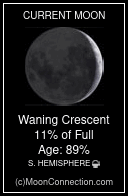| Lagrange Point |
French mathematician and astronomer Joseph Louis Lagrange showed that three bodies could lie at the apexes of an equilateral triangle which rotates in its plane. If one of the bodies is sufficiently massive compared with the other two, then the triangular configuration is apparently stable. Such bodies are sometimes referred to as Trojans. The leading apex of the triangle is known as the leading Lagrange point or L4; the trailing apex is the trailing Lagrange point or L5. |
| Lenticular Galaxy |
A disk-shaped galaxy that contains no conspicuous structure within the disk. Lenticular galaxies tend to look more like elliptical galaxies than spiral galaxies. |
| Libration |
An effect caused by the apparent wobble of the Moon as it orbits the Earth. The Moon always keeps the same side toward the Earth, but due to libration, 59% of the Moon's surface can be seen over a period of time. |
| Light Year |
The distance light travels in a vacuum in one year. 9.461 Pm (Peta = 10^15) |
| Limb |
The outer edge or border of a planet or other celestial body. |
| Local Group |
A small group of about two dozen galaxies of which our own Milky Way galaxy is a member. |
| Luminosity |
The amount of light emitted by a star. |
| Lunar Eclipse |
A phenomenon that occurs when the Moon passes into the shadow of the Earth. A partial lunar eclipse occurs when the Moon passes into the penumbra, or partial shadow. In a total lunar eclipse, the Moon passes into the Earth's umbra, or total shadow. |
| Lunar Month |
The average time between successive new or full moons. A lunar month is equal to 29 days 12 hours 44 minutes. Also called a synodic month. |
| Lunation |
The interval of a complete lunar cycle, between one new Moon and the next. A lunation is equal to 29 days, 12 hours, and 44 minutes. |
| Lunation number |
The count of New Moons since Jan 1923-01-17 02:41 UTC. New Mon on 26-Oct-2011 is start of Lunation 1099. |

